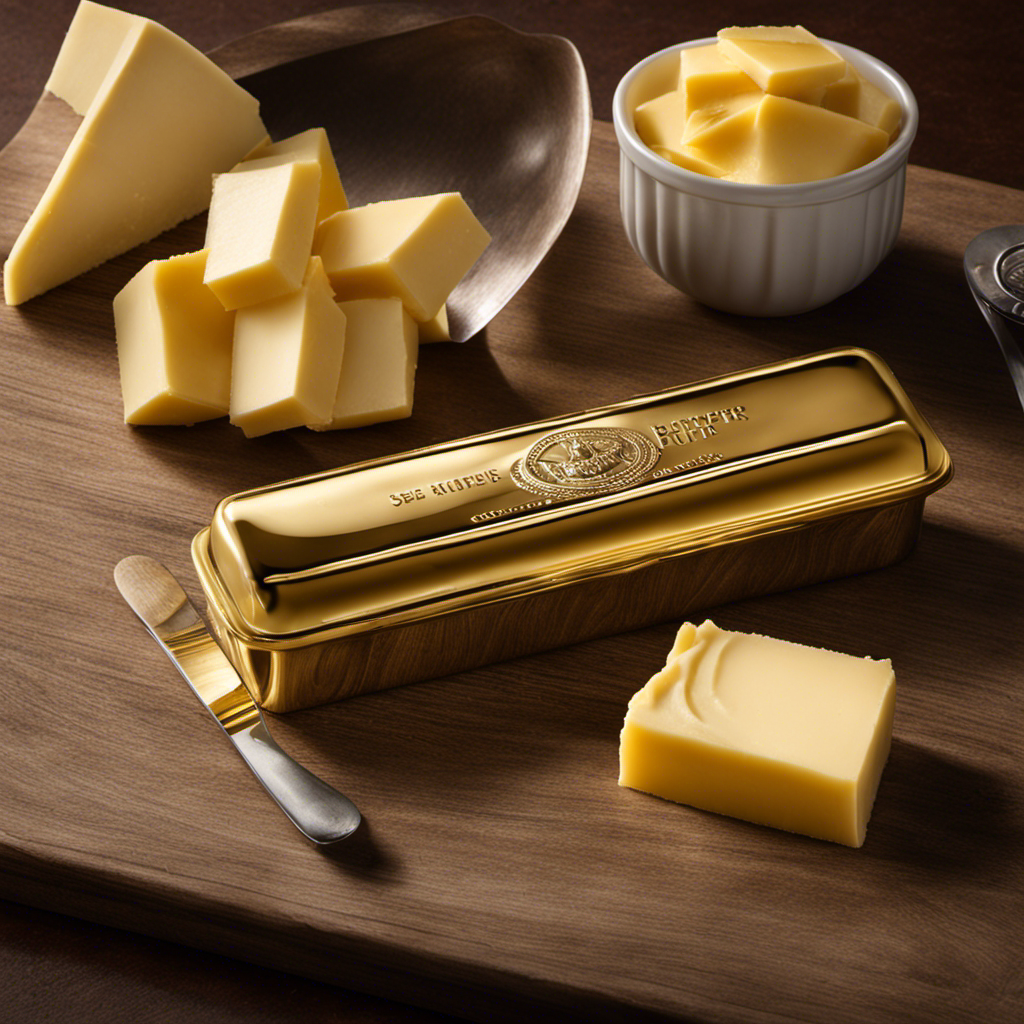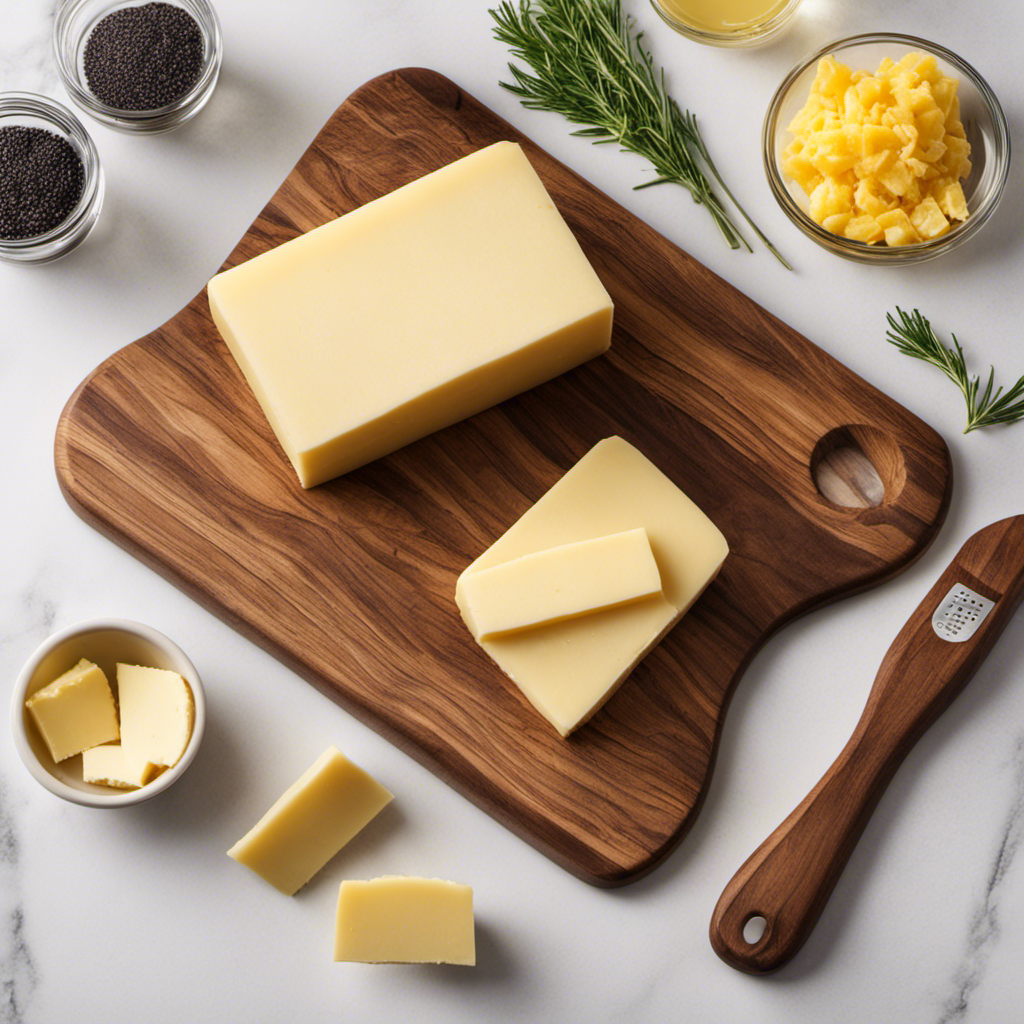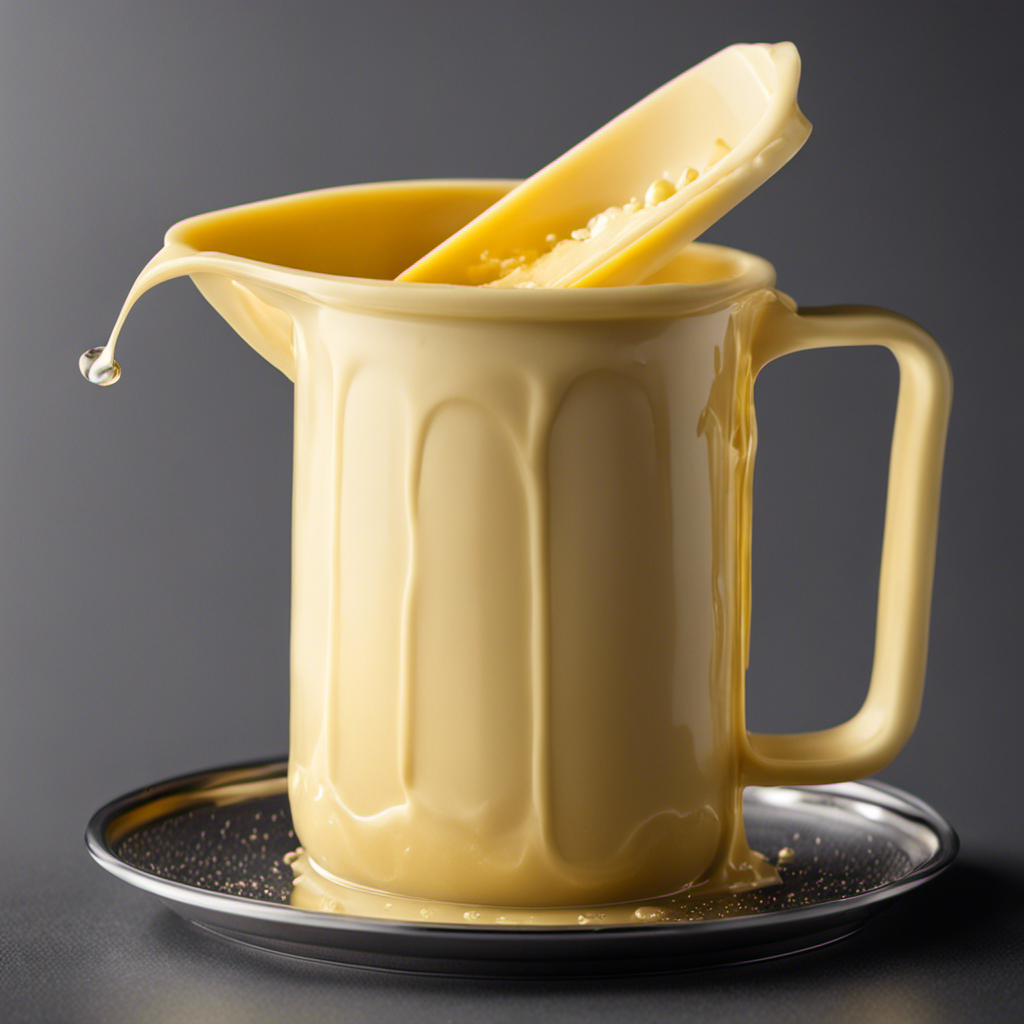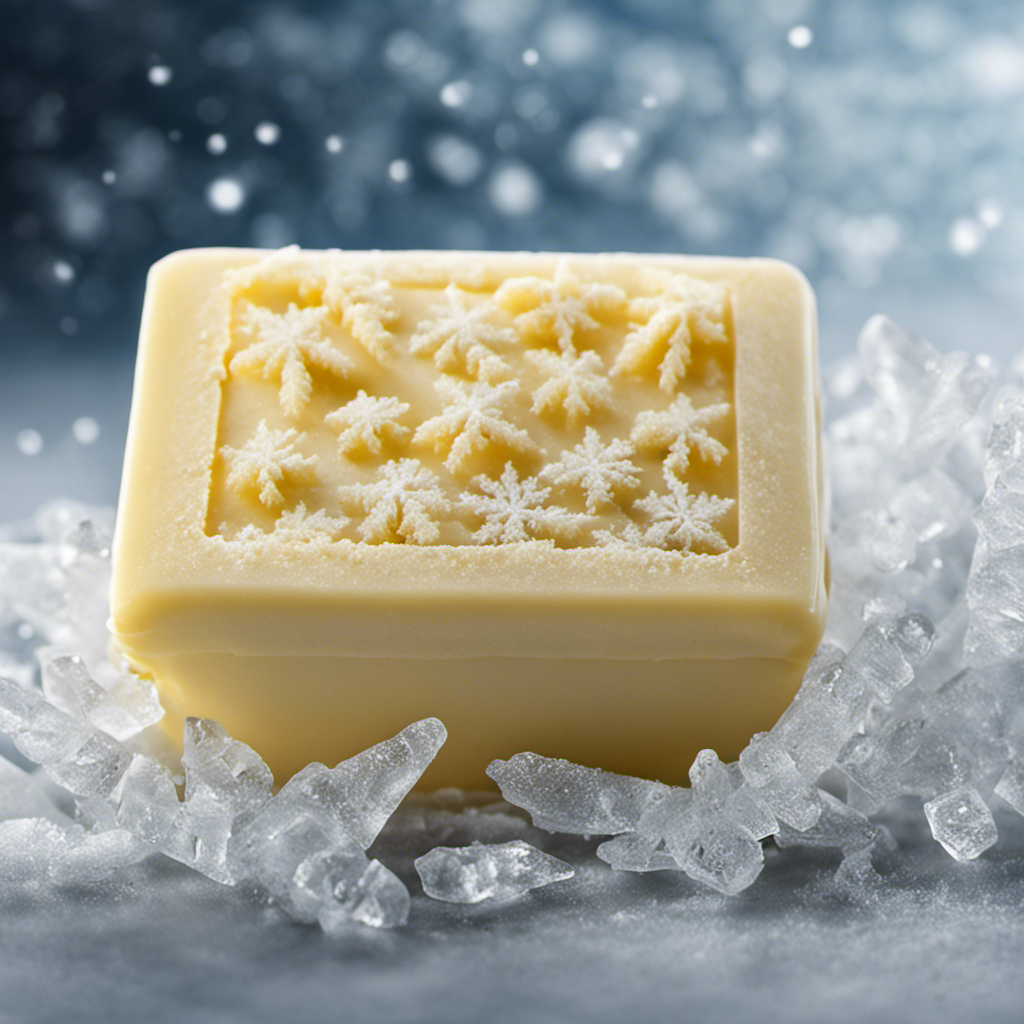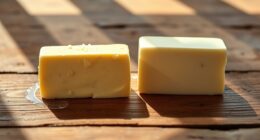Have you ever pondered the number of ounces contained in a stick of butter? I definitely have! Grasping the size measurements of butter sticks is vital for those who are passionate about cooking or baking.
In this article, we will explore the standard measurement for butter sticks and learn how to convert them into ounces. We will also discuss the importance of knowing these measurements and how they can affect the outcome of your recipes.
So, let’s dive in and discover just how many ounces are in a single stick of butter!
Key Takeaways
- A standard stick of butter typically weighs 4 ounces or 113 grams.
- Different countries may have different measurements for a standard stick of butter.
- Understanding butter stick measurements is crucial for accurate measurement in recipes and for proper proportions.
- Converting butter measurements allows for easy substitution and ensures consistent and delicious recipes.
The Different Measurements of Butter Sticks
Did you know that a stick of butter typically measures 4 ounces?
When it comes to measuring butter accurately, understanding the weight of a butter stick is crucial. Many recipes call for a specific number of butter sticks, and it’s important to know how much butter you need to use.
However, it’s also essential to adjust recipes based on the weight of the butter stick you have. For example, if a recipe calls for two sticks of butter, which equals 8 ounces, but your butter stick is only 3 ounces, you’ll need to adjust the amount accordingly.
Understanding the standard measurement for butter sticks is key to ensuring that your recipes turn out just right.
Understanding the Standard Measurement for Butter Sticks
Understanding the standard measurement for a stick of butter can be helpful in cooking and baking. Here are three important things to know about converting butter measurements and butter measurement equivalents:
-
A standard stick of butter in the United States is typically 1/2 cup or 8 tablespoons. This equals 4 ounces or 113 grams.
-
If a recipe calls for a different amount of butter than a standard stick, you can easily convert it by using the following equivalents:
- 1/4 cup or 4 tablespoons of butter is equivalent to half a stick.
- 1/2 cup or 8 tablespoons of butter is equivalent to one stick.
- 1 cup or 16 tablespoons of butter is equivalent to two sticks.
-
When measuring butter, it’s important to note that different countries may have different measurements for a standard stick. Make sure to check the specific conversion rates for the country you are in.
Converting Butter Sticks to Ounces
To convert a stick of butter to a different unit of measurement, you can easily use the provided equivalents. If you want to convert butter sticks to grams, a stick of butter typically weighs 113 grams or 4 ounces. This is a useful conversion to know, especially if you’re following a recipe that calls for grams instead of sticks.
But what if you don’t have a measuring cup? Don’t worry, there’s a simple trick to measure butter accurately without one. Just use the markings on the butter packaging. Most butter sticks have measurements etched into the wrapper, making it easy to slice off the exact amount you need. This way, you can ensure precise measurements without the need for additional tools.
Happy baking!
The Importance of Knowing Butter Stick Measurements
Knowing the correct measurements for butter sticks is essential when following recipes. It may seem like a small detail, but it can greatly affect the outcome of your dish. Here are three reasons why precise butter measurements are important:
-
Consistency: Using the right amount of butter ensures that your recipes turn out consistently delicious every time. Too much or too little butter can throw off the balance of flavors and texture.
-
Butter stick substitutes: Sometimes a recipe calls for a specific amount of butter sticks, but you only have a different form of butter. Knowing the measurements allows you to easily convert and substitute the correct amount.
-
Baking accuracy: Baking is a science, and precise measurements are crucial. Butter adds moisture, fat, and flavor to baked goods, so getting the amount right ensures the perfect texture and taste.
Understanding the importance of precise butter measurements sets the stage for the next question: how many ounces are in a single stick of butter?
How Many Ounces in a Single Stick of Butter
When it comes to baking, knowing the measurements of butter sticks is crucial. So, how many ounces are in a single stick of butter?
In this discussion, we will explore the importance of understanding butter stick measurements, common butter conversions, and how to effectively use butter in baking.
Butter Stick Measurements
Did you know that a stick of butter typically measures 4 ounces? When it comes to converting butter measurements, understanding the different butter stick sizes and weights is essential. Here are three key facts to keep in mind:
-
Standard Stick: The most common size is the standard stick, which weighs 4 ounces or 113 grams. It is typically marked with measurements on the packaging, making it easy to cut the desired amount.
-
Half Stick: If a recipe calls for a half stick of butter, it means you need 2 ounces or 57 grams. This smaller size is useful when you need less butter or want to control the fat content.
-
European Butter: European butter sticks are larger, weighing around 8 ounces or 227 grams. These creamy and rich butter sticks are a favorite among bakers for their high-fat content and superior flavor.
Understanding the various butter stick measurements will help you navigate recipes more accurately. Now, let’s delve into common butter conversions and explore different measurements and equivalents.
Common Butter Conversions
Understanding butter conversions can be helpful in accurately measuring and substituting this ingredient in recipes. When it comes to butter stick equivalents, it’s important to know how much butter is in a single stick. A standard stick of butter typically weighs 4 ounces or 113 grams. However, different countries may have different measurements for a stick of butter. For example, in the United States, a stick of butter is 8 tablespoons or 1/2 cup. In the United Kingdom, a stick of butter is 4 ounces or 110 grams. Adjusting recipes that call for butter can be easy once you know the conversions. Here’s a handy table to help you with common butter conversions:
| Measurement | United States | United Kingdom |
|---|---|---|
| 1 stick | 8 tablespoons | 4 ounces |
| 1/2 stick | 4 tablespoons | 2 ounces |
| 1/4 stick | 2 tablespoons | 1 ounce |
| 1/8 stick | 1 tablespoon | 1/2 ounce |
Now you can confidently adjust your recipes and measure butter accurately!
Baking With Butter
When it comes to baking, using the right ingredients is crucial for achieving the perfect results. Butter is a key ingredient in many baked goods, as it adds flavor, moisture, and richness to the final product. However, not all butter is created equal, and it’s important to choose the best option for your baking needs.
Here are three alternatives to traditional butter sticks that you can use in your baking:
-
Margarine: Margarine is a popular alternative to butter, especially for those who are looking for a dairy-free option. It has a similar texture and flavor to butter, making it a suitable substitute in most baking recipes.
-
Coconut oil: If you’re looking for a healthier alternative to butter, coconut oil is a great choice. It adds a subtle coconut flavor to your baked goods and provides a moist texture.
-
Vegetable shortening: Vegetable shortening is a solid fat made from vegetable oils. It has a high melting point, which makes it ideal for creating flaky pastries and pie crusts.
When choosing the best butter for baking, it’s important to consider the fat content. Look for butter with a higher fat content, as it will provide better results in terms of flavor and texture.
Now that we’ve explored the alternatives to butter sticks and discussed the best butter for baking, let’s dive into the mystery behind butter stick weight.
Unveiling the Mystery Behind Butter Stick Weight
Have you ever wondered why butter sticks come in a specific size?
In this discussion, we will uncover the mystery behind the standard butter stick size and explore how it relates to converting grams to ounces.
Understanding the weight of a butter stick will not only help you in the kitchen but also shed light on the fascinating world of measurement conversions.
Standard Butter Stick Size
The standard size for a stick of butter is 4 ounces. When it comes to converting butter measurements or comparing the weight of a butter stick to other ingredients, it’s important to keep this measurement in mind.
Here are some things to consider:
-
Baking recipes often call for sticks of butter as a measurement. Knowing that a stick weighs 4 ounces can help you accurately measure the amount of butter needed.
-
When comparing the weight of a stick of butter to other ingredients, such as sugar or flour, it’s helpful to know that 1 stick is equivalent to 1/2 cup or 8 tablespoons.
-
If a recipe calls for a different amount of butter than what a stick provides, you can easily convert it. For example, if you need 2 sticks of butter, that would be 8 ounces or 1 cup.
Understanding the standard size of a butter stick and how it relates to other measurements can make your baking endeavors much smoother.
Converting Grams to Ounces?
To convert grams to ounces, you can simply divide the number of grams by 28.35. This conversion is useful when you need to compare weights or measurements between the metric and imperial systems. For example, if you have 100 grams of an ingredient and want to know its equivalent in ounces, you would divide 100 by 28.35, which gives you approximately 3.53 ounces.
Here is a table to help you further with converting grams to ounces:
| Grams | Ounces |
|---|---|
| 50 | 1.76 |
| 100 | 3.53 |
| 150 | 5.29 |
| 200 | 7.05 |
Conversely, if you need to convert ounces to grams, you can multiply the number of ounces by 28.35. This will give you the weight in grams.
Now that we have covered converting grams to ounces, let’s explore the variations in butter stick weight across different brands.
Butter Stick Weight Variations Across Brands
You might be wondering about the weight variations of butter sticks across different brands. It’s interesting to see how the measurements can differ slightly, even though they all serve the same purpose.
Here are three factors that contribute to variations in butter stick measurements:
-
Manufacturing processes: Different brands may have slightly different methods for manufacturing their butter sticks, which can result in slight variations in weight.
-
Packaging: The packaging used for butter sticks can vary across brands. Some brands may use slightly thicker or thinner wrappers, which can affect the overall weight of the stick.
-
Ingredients: Butter sticks can have different water content percentages, which can impact their weight. Some brands may have higher water content, resulting in lighter sticks.
Understanding these variations is important when it comes to calculating butter stick weight for baking and cooking.
Now let’s dive into how to accurately measure the weight of a butter stick for all your culinary needs.
Calculating Butter Stick Weight for Baking and Cooking
When it comes to baking and cooking, accurately measuring butter is essential for achieving the desired results. One common challenge is converting butter stick measurements, as different brands may have variations in weight.
In this discussion, we will explore the importance of butter stick conversion and provide tips on how to measure butter accurately, ensuring your recipes turn out just right.
Butter Stick Conversion
A stick of butter is typically 4 ounces. However, it’s important to note that there can be variations in the weight of a butter stick depending on where you are located.
Here are some interesting facts about butter stick weight variations:
-
United States: In the United States, a stick of butter is commonly sold in a 4-ounce size. This is equivalent to 113.4 grams or 8 tablespoons.
-
Europe: In Europe, a stick of butter is typically 250 grams. This is equivalent to 8.8 ounces or 16 tablespoons.
-
Australia: In Australia, a stick of butter is usually 250 grams as well. This is equivalent to 8.8 ounces or 16 tablespoons, just like in Europe.
Measuring Butter Accurately
Now that we know how many ounces are in a stick of butter, let’s talk about measuring it accurately. When a recipe calls for a specific number of butter sticks, it’s important to measure them correctly to ensure the desired outcome. Here are some tips to help you get it right.
First, make sure your butter sticks are at room temperature. This will make them easier to measure and incorporate into your recipe.
Next, use a sharp knife to slice the butter stick into the required number of pieces. Each piece should be equal in size.
If your recipe calls for butter in tablespoons, simply refer to the butter stick equivalents chart we discussed earlier. This will help you determine the exact number of tablespoons you need.
How to Measure Butter Sticks Without a Scale
To measure butter sticks without a scale, you can use measuring cups or the markings on the butter packaging. Here are three methods you can try:
-
Measuring Cups: Most butter sticks are sold in 1/2 cup (8 tablespoons) or 1/4 cup (4 tablespoons) sizes. Simply cut the butter stick along the markings to get the desired amount.
-
Packaging Markings: Butter packaging often has measurements marked on the wrapper. These markings indicate tablespoons or ounces. Use a knife to cut the butter stick according to the desired measurement.
-
Water Displacement: Fill a measuring cup with water and note the level. Then, add the butter stick to the water, making sure it is fully submerged. The increase in water level will indicate the weight of the butter stick.
Using these methods, you can estimate the weight of butter sticks without a scale.
Common Conversions for Butter Stick Measurements
When it comes to baking, understanding butter measurements is crucial. In this discussion, I will be covering two key points: butter stick equivalents and metric conversions for butter.
Knowing these conversions will not only save you time in the kitchen, but also ensure your recipes turn out just right.
Butter Stick Equivalents
Did you know that a stick of butter is equivalent to 4 ounces? It’s a common measurement used in recipes, but there are times when you might run out of butter or prefer to use a substitute.
Here are some alternatives to a stick of butter:
-
Margarine: Margarine can be used as a substitute for butter in most recipes. It has a similar texture and taste, but make sure to use the same amount as you would with butter.
-
Coconut oil: If you’re looking for a dairy-free option, coconut oil can be a great substitute. It has a slightly different flavor, but it works well in baking and cooking.
-
Applesauce: For a healthier alternative, you can use applesauce instead of butter. It adds moisture to your recipes and works well in muffins, cakes, and breads.
When it comes to packaging, butter sticks are typically sold in a rectangular shape, wrapped in wax paper or foil. This makes it easy to measure and use in recipes.
Metric Conversions for Butter
You might find it helpful to know that butter is commonly measured in grams in metric conversions. When converting butter stick measurements to grams, it’s important to remember that one stick of butter is equal to 113 grams.
This information comes in handy when adjusting recipes based on butter stick weight. For example, if a recipe calls for 2 sticks of butter and you only have 1 stick, you can calculate the equivalent grams and adjust the recipe accordingly. In this case, you would use 113 grams of butter instead of the original 226 grams.
This allows you to maintain the correct ratio of ingredients and ensure the desired outcome of your recipe. So next time you’re in a pinch and need to convert butter stick measurements, just remember the handy conversion of 113 grams per stick.
Adjusting Recipes Based on Butter Stick Weight
To adjust recipes based on the weight of a stick of butter, simply divide the required amount of butter by 4. This will give you the amount of butter needed for one stick.
However, it’s important to note that the weight of a stick of butter can vary slightly depending on the brand or region. Here are some variations to keep in mind when adjusting recipes:
-
Standard stick of butter: In the United States, a stick of butter is typically 4 ounces or 113 grams.
-
European butter: European butter sticks are often larger, weighing around 8 ounces or 227 grams. When using European butter, you may need to adjust your recipe accordingly.
-
Homemade butter: If you’re making your own butter, the weight can vary depending on the method and ingredients used. It’s best to weigh your homemade butter before using it in a recipe.
The Role of Butter Stick Size in Recipe Success
The size of a butter stick plays an important role in the success of a recipe. When it comes to baking, the standard size for a butter stick is 1/2 cup or 4 ounces. This measurement is crucial because it ensures the right balance of fat and moisture in your baked goods.
However, if you find yourself without a butter stick, there are some substitutes you can use. Margarine, shortening, or coconut oil can be used as alternatives, but keep in mind that they may slightly affect the taste and texture of your final product.
It’s also worth noting that butter sticks can be useful in non-baking recipes as well. Whether you’re sautéing vegetables or making a sauce, the small, pre-measured portions of butter sticks make them convenient to use.
Tips for Accurately Measuring Butter Sticks
When accurately measuring butter, it’s important to press the butter into the measuring cup firmly to avoid any air gaps. This ensures that you get an accurate measurement and the right amount of butter for your recipe.
Here are some tips for measuring butter sticks accurately:
-
Use a butter dish with measurement markings: This makes it easy to measure the exact amount of butter you need without the hassle of using measuring cups.
-
Cut the butter stick into tablespoon increments: Most butter sticks are marked with tablespoon measurements. Simply slice the stick along the markings to get the desired amount.
-
Adjust your recipe accordingly: If your recipe calls for a different amount of butter than what a standard stick contains (usually 1/2 cup or 8 tablespoons), make the necessary adjustments by using a kitchen scale or a conversion chart.
Exploring Other Butter Measurements and Equivalents
Exploring different measurements and equivalents for butter can help you find the perfect amount for your recipe. When it comes to measuring butter accurately, it’s important to know the different options available.
Alongside the standard stick of butter, which typically weighs 4 ounces or 113 grams, there are other measurements that can be useful in adjusting recipes. For example, a tablespoon of butter is equivalent to half an ounce or 14 grams. This can be helpful when you need a smaller amount of butter or when you want to control the fat content in your dish.
Additionally, some recipes may call for butter in cups or pounds. One cup of butter is equal to 2 sticks or 8 ounces, while a pound of butter is equivalent to 4 sticks or 16 ounces.
Frequently Asked Questions
Can I Use a Different Measurement of Butter Besides Sticks in My Recipe?
Sure, you can use grams instead of sticks in your recipe. To convert butter measurements from tablespoons to sticks, divide the number of tablespoons by 8. It’s a simple way to adjust your recipe!
How Do I Accurately Measure Butter Sticks Without a Scale?
When it comes to accurately measuring butter sticks without a scale, I’ve found that using a simple conversion chart can be a lifesaver. Just remember, 1 stick of butter is equal to 1/2 cup or 8 tablespoons.
What Are Some Common Conversions for Butter Stick Measurements?
Converting butter measurements can be tricky. Grams and tablespoons are commonly used. It’s important to determine the appropriate butter measurement for different recipes.
How Do I Adjust My Recipe Based on the Weight of the Butter Stick?
To adjust my recipe, I need to know the weight of the butter stick. This affects the overall texture and taste. If I want to substitute butter, I should consider the conversion rate for accurate measurements.
Are There Any Other Measurements or Equivalents for Butter Besides Sticks and Ounces?
There are alternative butter measurements and different names for them. It’s helpful to know that butter is also measured in tablespoons, teaspoons, and grams.
Conclusion
As I held the stick of butter in my hand, I couldn’t help but marvel at its importance in the kitchen. Knowing how many ounces are in a stick of butter is crucial for any baker or cook.
It allows us to adjust recipes and ensure the perfect balance of flavors and textures. So next time you embark on a culinary adventure, remember to measure your butter sticks accurately and confidently.
Your taste buds will thank you for it.
